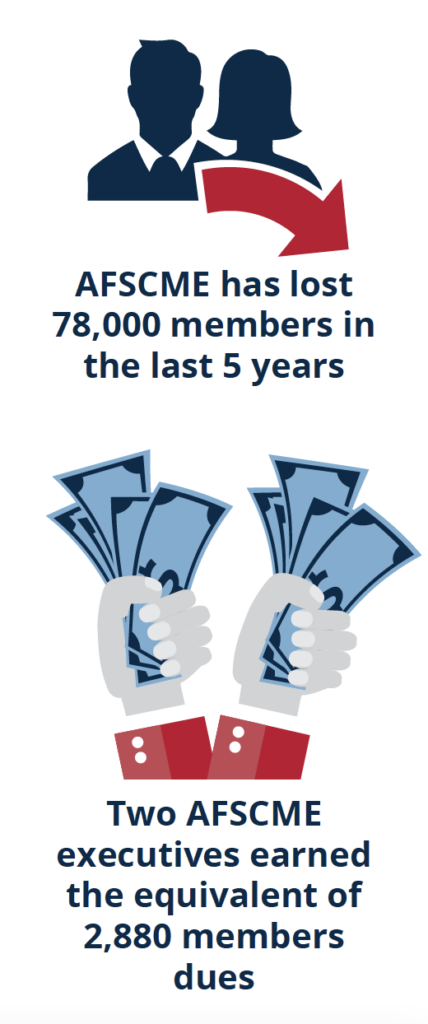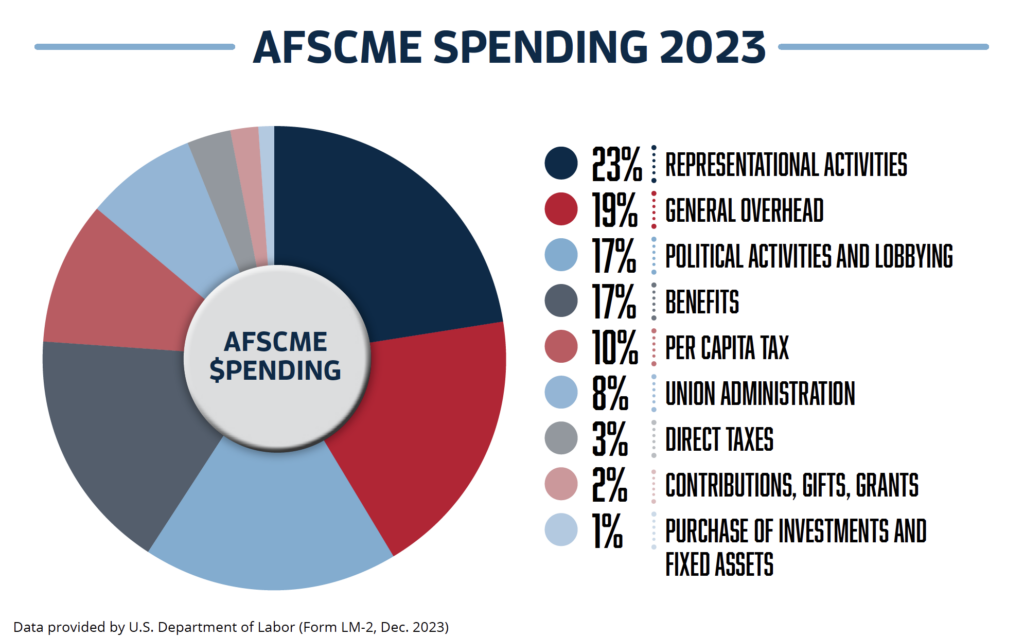The American Federation of State, County, and Municipal Employees (AFSCME) represents over 1.2 million workers throughout the country. Over the past 5 years, AFSCME has lost over 78,000 members. As a labor union that represents both public and private sector employees, AFSCME files a Form LM-2 financial disclosure with the United States Department of Labor. An examination of the union’s finances can help explain why the union is losing so many members.
Unions collect most of their money from membership dues. In 2023, membership dues accounted for over 86 percent of AFSCME’s revenue, with the national union charging $251.40 per member. As such, representing the members that pay these dues should be the top priority for any given union, but this is not the case for AFSCME. The organization’s latest filing, which covers January 1, 2023 through December 31, 2023, reveals that just 23 percent of AFSCME’s spending went toward representational activities. This begs the question: if AFSCME is not spending on its membership, how is it spending their dues?
Over half (57 percent) of AFSCME’s expenditures went toward just operating the union. Operating costs include general overhead expenses, union administration costs, purchasing stocks and bonds, paying for AFSCME employee benefits, and paying per capita tax to affiliated unions. Employee and executive salaries are also part of operating costs, with AFSCME executives earning significant compensation. AFSCME’s President, Lee Saunders, earned $398,105 in 2023, while Secretary- Treasurer Elissa McBride earned $326,048. Together, these two earned $724,153, the equivalent of 2,880 members’ annual dues.

Let’s Get Connected
We offer a free membership program, networking opportunities, and professional development scholarships to support qualifying public employees. Sign up today to receive updates from our team.

AFSCME Political Spending
Outside of operating costs, AFSCME spent membership dues on political activities and lobbying. In 2023, $27.8 million in membership dues went to supporting the union’s political activity, approximately 17 percent of all expenditures. Most of this spending went toward left-wing causes. AFSCME spent an additional $3.1 million on contributions, gifts, and grants. Though this spending category encompasses charitable giving, many unions give money to political non-profit organizations. AFSCME is no different, giving hundreds of thousands of dollars under this category to political organizations like Center for American Progress and the Progressive Caucus Action Fund.
According to federal law, member dues can be used for a variety of political activities, such as issue advocacy, getout- the-vote drives, election mailers, lobbying, and public marketing campaigns. The Janus v. AFSCME Supreme Court decision relieves nonmembers from the obligation to pay any dues or fees to the union as a condition of public employment. However, for workers who remain AFSCME members, Janus changes nothing about how union dues are spent: they are still routinely used for political purposes. During the latest reporting period, AFSCME gave:

AFSCME Financial Health
In all, AFSCME spent $159 million in 2023 and brought in $207 million. Despite significant membership losses over the past 5 years, the union holds a strong financial position with over $310 million in net assets. Since 2021, AFSCME’s net financial position has improved by $63.8 million. AFSCME has been able to sustain a strong financial position despite membership losses due to increased membership dues. Since the 2018 reporting period, AFSCME’s annual membership dues have increased by over $30. If AFSCME continues to raise dues while failing to spend to represent its members, the union may continue to see steep membership drops.